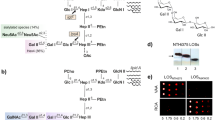Abstract
Pseudomonas aeruginosa may cause serious infections in most human tissues/organs. Its adherence to them is mediated by a battery of adhesins including the PA-I and PA-II lectins, which are produced in this bacterium in high quantities. PA-I binds to thed-galactose of the erythrocyte glycosphingolipids exhibiting highest affinities for B and Pk (followed by P1) antigens, while PA-II preferentially binds to thel-fucose of H, A and B antigens. IntactP. aeruginosa cells also exhibit a clear Pk and P1 over p preference. Such affinities for the most common human ABH and P system antigens may underlie the widespread tissue infectivity and pathogenicity of this bacterium.
Similar content being viewed by others
References
Sabath LD (ed.) (1980) InPseudomonas aeruginosa, the Organism, Diseases it Causes, and their Treatment. Bern: Hans Huber Publishers.
Vasil ML (1986)J Pediatr 108:800–5.
Morihara K, Homma JY (1985) InBacterial Enzymes and Virulence (Holder IA, ed.) pp. 41–79. Boca Raton, FL: CRC.
Wood RE, Iglewski BH (1983)Rev Infect Dis 5:715–21.
Duguid JP, Old DC (1980) InBacterial Adherence (Beachey EH, ed.) pp. 187–217. London: Chapman & Hall Ltd.
Sharon N (1987)FEBS Lett 217:145–57.
Krivan HC, Roberts DD, Ginsburg V (1988)Proc Natl Acad Sci USA 85:6157–61.
Prince A (1992)Microbial Pathogenesis 13:251–60.
Gilboa-Garber N, Garber N (1992) InGlycoconjugates: Composition, Structure and Function (Allen HJ, Kisailus EC, eds) pp. 541–91. New York: Marcel Dekker Inc.
Gilboa-Garber N (1972)FEBS Lett 20:242–44.
Garber N, Sharon N, Shohet D, Lam JS, Doyle RJ (1985)Infect Immun 50:336–37.
Ramphal R, Sadoff JC, Pyle M, Silipigni JD (1984)Infect Immun 44:38–40.
Gilboa-Garber N (1982)Methods Enzymol 83:378–85.
Glick J, Garber N (1983)J Gen Microbiol 129:3085–90.
Race RR, Sanger R (1975)Blood Groups in Man, 6th edition. Oxford: Blackwell Scientific Publications.
Hakomori S (1986)Sci Amer 254:44–53.
Levene C, Gilboa-Garber N, Garber NC (1994) inLectin-Microorganism Interactions (Doyle RJ, Slifkin M, eds) pp. 327–93. New York: Marcel Dekker, Inc.
Anstee DJ, Holt PDJ, Pardoe GI (1973)Vox Sang 25:347–60.
Voak D, Todd GM, Pardoe GI (1974)Vox Sang 26:176–88.
Källenius G, Möllby R, Svenson SB, Winberg J, Lundblad A, Svensson S, Cedergren B (1980)FEMS Microbiol Lett 7:297–302.
Korhonen TK, Väisänen V, Saxén H, Hultberg H, Svenson SB (1982)Infect Immun 37:286–91.
Baker N, Hansson GC, Leffler H, Riise G, Svanborg-Eden C (1990)Infect Immun 58:2361–66.
Ramphal R, Carnoy C, Fievre S, Michalski JC, Houdret N, Lamblin G (1991)Infect Immun 59:700–4.
Baker NR, Minor V, Deal C, Shahrabadi MS, Simpson DA, Woods DE (1991)Infect Immun 59:2859–63.
Issitt PD (1985) InApplied Blood Group Serology, 3rd edition, pp. 203–18. Miami: Montgomery Scientific Publication.
Author information
Authors and Affiliations
Rights and permissions
About this article
Cite this article
Gilboa-Garber, N., Sudakevitz, D., Sheffi, M. et al. PA-I and PA-II lectin interactions with the ABO(H) and P blood group glycosphingolipid antigens may contribute to the broad spectrum adherence ofPseudomonas aeruginosa to human tissues in secondary infections. Glycoconjugate J 11, 414–417 (1994). https://doi.org/10.1007/BF00731276
Received:
Revised:
Issue Date:
DOI: https://doi.org/10.1007/BF00731276




